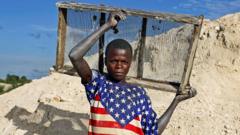---
The Trump administration's latest endeavor aims to bring an end to the longstanding conflict in eastern Democratic Republic of Congo (DRC), a region rich in minerals essential for technology and green energy, including cobalt and lithium. Expected to host key leaders from DRC and Rwanda soon, Trump is touting this peace initiative as a way to secure vital resources currently dominated by China.
World Peace Foundation's Prof Alex de Waal highlights the administration's method of intertwining peace-making with commercial interests, suggesting Trump's motivations for favorable outcomes are partly self-serving. DRC's historical investment caution is recognized, as concerns over "blood minerals" have long deterred U.S. firms.
While this peace process might draw attention away from international competitors, experts warn about potential compromises in DRC’s mineral sovereignty. Prof Hanri Mostert emphasizes the risks involved, noting that past resource-barriering deals have often left African nations unable to reap fair value from their resources.
The U.S. State Department estimates DRC boasts about $25 trillion in mineral reserves, vital for modern technology. Spokespersons from the DRC confirmed intentions to secure deals that could enhance U.S. access in exchange for security guarantees.
Amid claims of mineral smuggling involving the M23 rebel faction and Rwandan interests, the proposed peace deal seeks to create a framework aimed at blocking illicit trade while fostering mutual economic partnerships. Trump indicated that a portion of DRC's mineral rights would likely be allocated to the U.S. as part of the agreement, which was signed on June 27.
To coordinate efforts, the peace framework includes a "security coordination mechanism," aimed at establishing stability and ensuring that both nations work closely to manage security threats posed by the M23 and other factions. Some observers, like political analyst Prof Jason Stearns, express concerns about the complexity of simultaneous negotiations facilitated by the U.S. and regional allies such as Qatar.
As tensions remain high within DRC's borders, alliance-specific resolutions are crucial to understand the operational dynamics of both foreign actors and rebel groups. The peace initiative could significantly impact the trajectory of conflict resolution efforts in the region, although many challenges remain.
International experts urge for a well-balanced approach that acknowledges deep-rooted historical injustices and prioritizes regional participation in dialogue, suggesting that Trump’s engagement must extend beyond mere diplomatic gestures to create lasting peace.
As DRC navigates its difficult path towards stability, the impact of foreign investment and resource exploitation will be a critical lens through which its future is determined. However, experts caution that simply achieving a signed agreement does not guarantee sustainable peace in a land rich in both resources and conflict.
The Trump administration's latest endeavor aims to bring an end to the longstanding conflict in eastern Democratic Republic of Congo (DRC), a region rich in minerals essential for technology and green energy, including cobalt and lithium. Expected to host key leaders from DRC and Rwanda soon, Trump is touting this peace initiative as a way to secure vital resources currently dominated by China.
World Peace Foundation's Prof Alex de Waal highlights the administration's method of intertwining peace-making with commercial interests, suggesting Trump's motivations for favorable outcomes are partly self-serving. DRC's historical investment caution is recognized, as concerns over "blood minerals" have long deterred U.S. firms.
While this peace process might draw attention away from international competitors, experts warn about potential compromises in DRC’s mineral sovereignty. Prof Hanri Mostert emphasizes the risks involved, noting that past resource-barriering deals have often left African nations unable to reap fair value from their resources.
The U.S. State Department estimates DRC boasts about $25 trillion in mineral reserves, vital for modern technology. Spokespersons from the DRC confirmed intentions to secure deals that could enhance U.S. access in exchange for security guarantees.
Amid claims of mineral smuggling involving the M23 rebel faction and Rwandan interests, the proposed peace deal seeks to create a framework aimed at blocking illicit trade while fostering mutual economic partnerships. Trump indicated that a portion of DRC's mineral rights would likely be allocated to the U.S. as part of the agreement, which was signed on June 27.
To coordinate efforts, the peace framework includes a "security coordination mechanism," aimed at establishing stability and ensuring that both nations work closely to manage security threats posed by the M23 and other factions. Some observers, like political analyst Prof Jason Stearns, express concerns about the complexity of simultaneous negotiations facilitated by the U.S. and regional allies such as Qatar.
As tensions remain high within DRC's borders, alliance-specific resolutions are crucial to understand the operational dynamics of both foreign actors and rebel groups. The peace initiative could significantly impact the trajectory of conflict resolution efforts in the region, although many challenges remain.
International experts urge for a well-balanced approach that acknowledges deep-rooted historical injustices and prioritizes regional participation in dialogue, suggesting that Trump’s engagement must extend beyond mere diplomatic gestures to create lasting peace.
As DRC navigates its difficult path towards stability, the impact of foreign investment and resource exploitation will be a critical lens through which its future is determined. However, experts caution that simply achieving a signed agreement does not guarantee sustainable peace in a land rich in both resources and conflict.





















